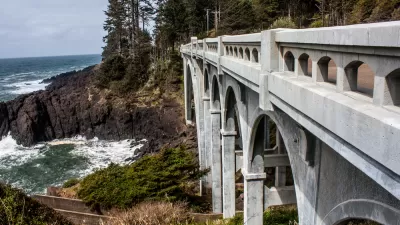State DOTs generally have not been viewed as the most progressive forces in transportation, often perceived primarily as road builders. So a recent "challenge" to drive less, if only for 12 days, came as a surprise. But hey, it's Oregon!
Why would the Oregon Department of Transportation (ODOT) sponsor such a challenge?
Reducing congestion is understandable, as that's in the mission of most state DOTs, but ODOT's goals were also to reduce greenhouse gas emissions and fuel use by reducing vehicle miles traveled (VMT), according to the AASHTO Journal.
The campaign, which ran from Oct. 21-Nov. 1, encouraged Oregon drivers to seek other forms of transportation for those 12 days, including walking, biking, taking public transportation, or carpooling. ODOT's goal was to eliminate 500,000 vehicle miles traveled by single drivers from the roadways.
The outcome surpassed ODOT's goals. According to their report, "thousands of participants cut more than 900,000 miles during that 12-day period. Those vehicle miles were reduced in many ways, as participants logged 21,885 bike trips, 12,500 carpool occurrences, 9,902 bus rides, 2,561 light rail trips, 147 streetcar rides, 7,805 walking trips, 2,106 telework instances, and 990 vanpool trips."
The result: "Elimination of 652,960 pounds of carbon dioxide emissions while saving 33,608 gallons of gas and $223,479." ODOT is contributing to the state effort "to reduce these emissions to levels 75 percent below those experienced in 1990 by 2050. The Drive Less Challenge was created to have an impact on those numbers while also creating more awareness for citizens of their transportation options and behaviors," writes AASHTO.
As we posted here earlier, Oregon signed the Pacific Coast Action Plan on Climate and Energy (PDF) on Oct. 28 to reduce these emissions. And then there's ODOT's commitment to intermodalism that we described here last May. All of which makes ODOT not your typical DOT.
As for participants in the Challenge program, winners were rewarded with gifts that included a $2,600 credit for a custom-built folding bike and annual transit passes,
Correspondent's note: It appears that ODOT refers to both the Oregon Department of Transportation and Ohio DOT. Confusing?
FULL STORY: Oregon DOT Surpasses Goals in Drive Less Challenge

Alabama: Trump Terminates Settlements for Black Communities Harmed By Raw Sewage
Trump deemed the landmark civil rights agreement “illegal DEI and environmental justice policy.”

Planetizen Federal Action Tracker
A weekly monitor of how Trump’s orders and actions are impacting planners and planning in America.

The 120 Year Old Tiny Home Villages That Sheltered San Francisco’s Earthquake Refugees
More than a century ago, San Francisco mobilized to house thousands of residents displaced by the 1906 earthquake. Could their strategy offer a model for the present?

Ken Jennings Launches Transit Web Series
The Jeopardy champ wants you to ride public transit.

BLM To Rescind Public Lands Rule
The change will downgrade conservation, once again putting federal land at risk for mining and other extractive uses.

Indy Neighborhood Group Builds Temporary Multi-Use Path
Community members, aided in part by funding from the city, repurposed a vehicle lane to create a protected bike and pedestrian path for the summer season.
Urban Design for Planners 1: Software Tools
This six-course series explores essential urban design concepts using open source software and equips planners with the tools they need to participate fully in the urban design process.
Planning for Universal Design
Learn the tools for implementing Universal Design in planning regulations.
Clanton & Associates, Inc.
Jessamine County Fiscal Court
Institute for Housing and Urban Development Studies (IHS)
City of Grandview
Harvard GSD Executive Education
Toledo-Lucas County Plan Commissions
Salt Lake City
NYU Wagner Graduate School of Public Service





























